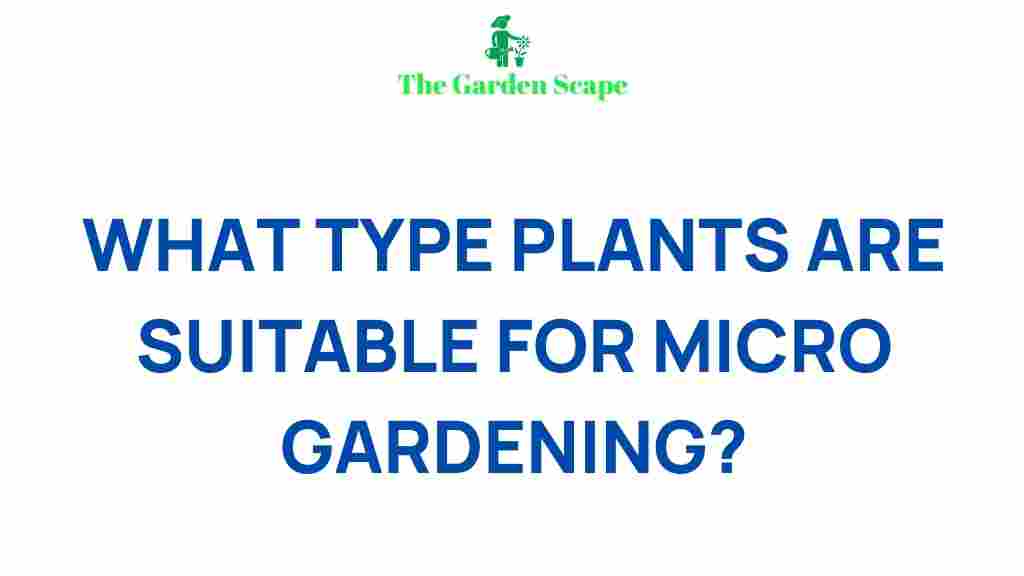In today’s world, where urbanization is on the rise, many are finding solace in the green escape of gardening. But what if you’re short on space? *Micro gardening* is the perfect solution! With the right plants and a bit of creativity, you can transform even the smallest spaces into a thriving garden. This guide will explore the best plants for micro gardening and help you unlock the full potential of your compact green space.
What is Micro Gardening?
Micro gardening is the art and science of growing plants in small, confined spaces. Whether it’s a windowsill, balcony, or a tiny backyard, micro gardening offers a way to cultivate fresh herbs, vegetables, and flowers using innovative techniques.
This approach is not only eco-friendly but also ideal for urban dwellers who crave greenery. Plus, it provides access to fresh produce and improves mental well-being.
Discovering the Best Plants for Micro Gardening
Choosing the right plants is crucial for successful micro gardening. Not all plants thrive in limited spaces, so it’s essential to select varieties that grow well in containers and have compact growth habits.
Herbs: A Micro Gardener’s Delight
- Basil: Easy to grow and highly aromatic, basil is a micro gardening favorite.
- Mint: Known for its refreshing flavor, mint thrives in small containers.
- Thyme: A resilient herb perfect for beginners.
- Parsley: A versatile herb that grows well indoors or outdoors.
These herbs require minimal space and are perfect for adding a burst of flavor to your meals.
Vegetables: Compact Crops for Micro Gardens
- Cherry Tomatoes: Ideal for small spaces and grow well in hanging baskets.
- Radishes: Quick-growing and perfect for shallow containers.
- Leafy Greens: Lettuce, spinach, and arugula thrive in compact settings.
- Peppers: Miniature varieties are perfect for micro gardening.
With careful planning, you can enjoy a bountiful harvest of fresh vegetables from your micro garden.
Flowers: Adding Color to Your Micro Garden
- Marigolds: Bright and cheerful, these flowers are also pest deterrents.
- Pansies: Perfect for cooler climates and add a splash of color.
- Petunias: Low-maintenance and ideal for hanging containers.
- African Violets: Excellent for indoor micro gardening.
Incorporating flowers not only beautifies your space but also attracts pollinators like bees and butterflies.
How to Set Up a Micro Garden
Setting up a micro garden is simpler than you might think. Follow these steps to get started:
Step 1: Choose Your Space
Identify a suitable area with access to sunlight, such as a windowsill, balcony, or patio. Consider vertical spaces like walls or railing for hanging planters.
Step 2: Select the Right Containers
Choose containers based on the plants you wish to grow. Options include ceramic pots, recycled jars, or wooden crates. Ensure they have proper drainage holes.
Step 3: Prepare the Soil
Opt for a high-quality potting mix that retains moisture while providing adequate drainage. Enrich the soil with organic compost for better yield.
Step 4: Plant Your Choices
Plant seeds or seedlings according to their spacing requirements. Avoid overcrowding to ensure proper growth and airflow.
Step 5: Water and Maintain
Water your micro garden consistently but avoid overwatering. Prune regularly to keep your plants healthy and tidy.
Troubleshooting Common Micro Gardening Challenges
Micro gardening may come with its challenges, but most issues can be addressed with simple solutions:
Poor Drainage
If water pools at the bottom of your containers, your plants may suffer from root rot. Always use pots with drainage holes and avoid overwatering.
Limited Sunlight
Urban settings may restrict access to direct sunlight. In such cases, use grow lights to supplement natural light.
Pests and Diseases
Common pests like aphids and spider mites can harm your micro garden. Use organic pest control methods, such as neem oil or introducing beneficial insects.
Overcrowding
Planting too many varieties in a small space can lead to competition for nutrients. Stick to the recommended spacing for each plant type.
Benefits of Micro Gardening
Micro gardening offers numerous benefits that make it an appealing hobby:
- *Space Efficiency:* Perfect for urban dwellers with limited outdoor areas.
- *Sustainability:* Reduces food miles and promotes self-sufficiency.
- *Mental Well-being:* Gardening can be therapeutic and stress-relieving.
- *Fresh Produce:* Enjoy fresh, organic fruits, vegetables, and herbs right at home.
Conclusion
Micro gardening is a rewarding and sustainable way to bring nature into your urban lifestyle. By selecting the best plants for micro gardening and following the tips outlined above, you can create a lush, productive space no matter how small.
Ready to get started? Check out our comprehensive beginner’s guide to gardening for more tips and tricks. For additional inspiration, explore Royal Horticultural Society’s advice on sustainable gardening practices.
Start your micro gardening journey today and watch your small space come alive with greenery and life!
This article is in the category Garden Design and created by TheGardenScape Team
